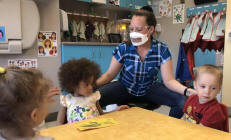-
Early Beginnings
The history of child care
in Canada dates
 back
to 1828 when the first infant school opened in Montreal, influenced by
European models. These early institutions, such as crèches and infant
schools, were initially aimed at supporting poor working families with
basic custodial care and early education (Prochner & Howe, 2011). Often
run by religious or charitable women-led organizations, these services
carried a moralistic tone, reflecting broader concerns about poverty and
national identity.
back
to 1828 when the first infant school opened in Montreal, influenced by
European models. These early institutions, such as crèches and infant
schools, were initially aimed at supporting poor working families with
basic custodial care and early education (Prochner & Howe, 2011). Often
run by religious or charitable women-led organizations, these services
carried a moralistic tone, reflecting broader concerns about poverty and
national identity.
-
Kindergarten Movement and Public Education
By the late 19th century,
the kindergarten movement, inspired by Froebel’s
child-centered
philosophy, gained popularity in Canada. The first public kindergarten
was established in Toronto in 1883, serving children aged five to seven.
Over time, kindergartens became part of the public education systems in
various provinces like Nova Scotia, Quebec, and Manitoba. Alongside
kindergartens, nursery schools and day nurseries emerged, often tied to
health, hygiene, and social welfare goals, signaling an intersection
between early childhood care and state-building (Prochner & Howe, 2011).
-
Professionalization and Family Child Care
Initially informal and unregulated, Family Child
Care (FCC) evolved toward standardized practices with the
creation of environmental rating scales. The Family Day Care Rating
Scale (FDCRS) introduced over 30 years ago marked a key turning point.
Later tools, like FCCERS-R and FCCERS-3, refined the focus to
caregiver-child interaction and cognitive development. These tools
became internationally adopted, reflecting a global trend toward quality
assurance and professionalization in home-based care (Eckhardt & Egert,
2020).
-
Expansion and Cultural Change
From the 1980s, the child care landscape in
Canada saw significant
 growth.
In 1986, there were fewer than 200,000 licensed child care spaces, and
only 6% of children of employed mothers were in center-based care. By
2019, licensed spaces surged to nearly 1.4 million, and 49% of children
with working mothers were enrolled in center care. Full-day kindergarten
for four- and five-year-olds became widely available, further embedding
early childhood education in public systems (Cleveland, 2022).
growth.
In 1986, there were fewer than 200,000 licensed child care spaces, and
only 6% of children of employed mothers were in center-based care. By
2019, licensed spaces surged to nearly 1.4 million, and 49% of children
with working mothers were enrolled in center care. Full-day kindergarten
for four- and five-year-olds became widely available, further embedding
early childhood education in public systems (Cleveland, 2022).
-
Impact of COVID-19
The COVID-19 pandemic disrupted child car e
access. In 2019, 60% of children aged 0–5 were in care, but this dropped
to 52% in 2020 and 2022 due to closures. By 2023, the rate partially
recovered to 56%, with increased demand highlighted by growing waitlists
- 26% of non-attending children were on lists in 2023 (Statistics
Canada, 2023).
e
access. In 2019, 60% of children aged 0–5 were in care, but this dropped
to 52% in 2020 and 2022 due to closures. By 2023, the rate partially
recovered to 56%, with increased demand highlighted by growing waitlists
- 26% of non-attending children were on lists in 2023 (Statistics
Canada, 2023).